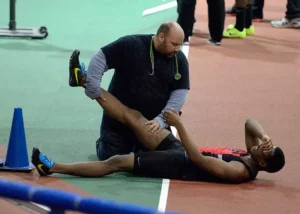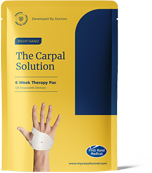

Doctors’ Recommendations for Patients who have Persistent Symptoms of Carpal Tunnel Syndrome and Those Who Want to Accelerate their Recovery from CTS.
Thank you for your commitment to use the Carpal Solution. Neurologists say it is the best first line treatment to get control of your Carpal Tunnel Syndrome while protecting yourself from the risks and potential complications of repeated surgical procedures. Most people get complete control of Carpal Tunnel Syndrome within the Six Week Protocol developed by the Doctors. However, some people (about 15%) have what the Doctor calls “Persistent Symptoms of Carpal Tunnel Syndrome”.
If you believe you have Persistent Carpal Tunnel Symptoms, we can help you, there is hope. Thousands of people have managed Persistent Carpal Tunnel Symptoms following the Doctors’ Protocol without resorting to repeated surgical procedures. Following these recommendations will also help accelerate recovery for most people suffering from Carpal Tunnel Syndrome. Even those who do not have Persistent Symptoms will accelerate their natural healing by following the Doctors’ Procedure for Patients with Persistent Symptoms of Carpal Tunnel Syndrome.
Watch this video of a Surgical Nurse Who had Persistent Symptoms of Carpal Tunnel Syndrome. She did not feel any improvement until the 5th week of treatment and then experienced a full recovery. Now she uses the Carpal Solution Therapy about once every two years and keeps Carpal Tunnel completely under control from home without the downtime, risks and potential complications of Carpal Tunnel Surgery.
Carpal Tunnel Syndrome is cyclical in nature and once you break the cycle that is creating pressure on the nerve, you can put the symptoms in remission for 2 to 7 years, without any further treatment, in most cases. There is no cure. Carpal Tunnel comes back even after surgery.
 As a nerve disorder it is common for People with CTS to respond differently to therapy of any kind. There is a wide range of responses from patients. Some patients get rid of their worst symptoms in the first night of Carpal Solution Therapy. Most people get better within two to three weeks of consistent Carpal Solution Therapy.
As a nerve disorder it is common for People with CTS to respond differently to therapy of any kind. There is a wide range of responses from patients. Some patients get rid of their worst symptoms in the first night of Carpal Solution Therapy. Most people get better within two to three weeks of consistent Carpal Solution Therapy.
Some people with persistent symptoms experience 40% to 80% relief in the first six weeks and need to continue with a more aggressive therapy to get complete remission. It usually takes 10 – 12 weeks of total Therapy to put Carpal Tunnel in remission. Then it goes away for anywhere from 2 to 7 years.
Others experience the Soft Tissue Transition where their Symptoms start feeling worse for a week or two before they start to improve.
Still other people feel no relief, but are determined to avoid surgery and it can take up to 5 weeks before they start feeling any relief from the therapy like surgical nurse Kathy in the video.
Some people use this protocol while they are waiting to receive their Carpal Solution Therapy package. Whatever the case with you, you will find that doing these additional steps will help to accelerate the natural healing your body is capable of doing. The emphasis here is on the natural healing of soft tissue injury. It is the best way for most people to control their Carpal Tunnel Symptoms.
The good news is that most people can get these persistent symptoms under control without resorting to the risks of surgery, nor the risks of repeated steroid injections. It just takes a little more time and a little extra work. Most people say it was well worth the added effort and cost to get relief naturally without the risks of these invasive medical procedures, knowing that Carpal Tunnel Surgery only works for about 50 -60% of people. Even those people with successful surgical procedures find that their symptoms come back and they are required to repeat surgery or try an alternate therapy. This is why Neurologists say that the Carpal Solution is the best first line of defense for Carpal Tunnel Syndrome.
Computer Network Engineer works 14 – 16 hours per day on the computer and then works on remodeling his home. “If I can cure Carpal Tunnel without surgery the way I abuse my hands, then I believe anyone can with the Carpal Solution!”
It is actually a good sign that you are now experiencing some relief, but also some increased discomfort at times. Some people with persistent symptoms feel no relief, but feel like their symptoms are getting worse. This happens to about 10% of people and ironically is actually a signal that the Carpal Solution is working. People with CTS respond differently to the therapy.
 Sometimes stretching therapy does cause discomfort for a few weeks, just like stretching for an athlete before an athletic event can be somewhat uncomfortable, but the stretching helps them restore flexibility to their muscles and joints before they perform.
Sometimes stretching therapy does cause discomfort for a few weeks, just like stretching for an athlete before an athletic event can be somewhat uncomfortable, but the stretching helps them restore flexibility to their muscles and joints before they perform.
If you are determined, you can still get your Carpal Tunnel under control without resorting to the risks of surgical procedures. What the Doctors recommend to their patients is an extended Carpal Solution Protocol combined with daily alternating Ice and Heat Therapy, Anti-Inflammatory Medication, and Daytime stretching Therapy also combined with Interferential Current Therapy two or three times per week.
Thousands of people have conquered the persistent symptoms of Carpal Tunnel Syndrome with the Carpal Solution as their base therapy and adding the other steps discussed in detail below.
At this point, it would be best to order the 1 Year Carpal Solution Therapy Pac (56 disposable devices, the economy pack), since it will take another 4 to 6 weeks to get your symptoms under complete control and then use it once a week for one to two months after it is in remission. It is the most cost effective way to purchase the Carpal Solution Treatment. Now that you know that it works, it is an easy to decision to move forward with confidence based on firsthand experience of Doctors working with patients. Stay positive and have faith, you are almost there.
With the link below you can access for free the doctors recommendations for patients that have persistent Carpal Tunnel Symptoms and are determined to avoid repeated surgical procedures which are common with CTS:
 Created by renowned Harvard health care professionals.
Created by renowned Harvard health care professionals. 



